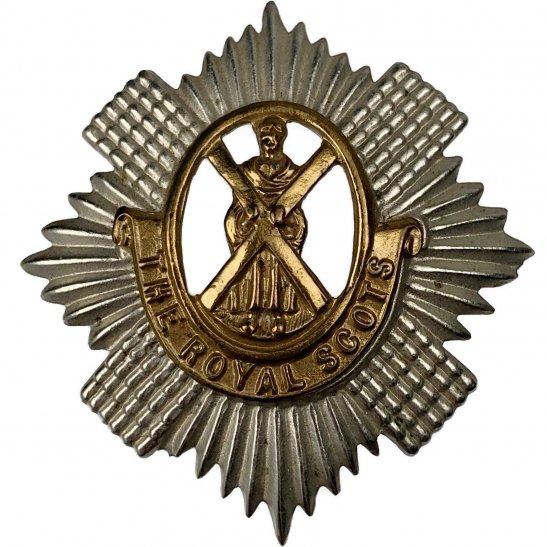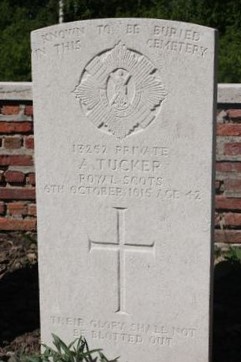
Andrew Tucker was born on 7 January, 1873, in the district of St. George, at Edinburgh, in Scotland, the eldest of two known sons to David Tucker, a rope maker, and Ellen (Helen) Tucker (formally Stewart). He had one younger brother, David (1875). His mother died in 1877, and his father re-married in 1880, one Agnes Prentice, with whom he had four known children, half-siblings to Andrew and David: James (1880); Margaret (1881); Mary Stewart (1887); and Agnes (1890).
By 1881 the family was living at 3 Dunbar Street, and ten years later at 8 Freer Street, by which time, Andrew, aged 18, was employed as a brass moulder.
On 14 October, 1892, Andrew Tucker married Mary Devlin at All Saints Church, in Brougham Street, Edinburgh, and by 1901, and still employed as a brass moulder, Andrew was living with his family at 6 Brandfield Street.
In 1911 Andrew Tucker was boarding at 7 Watson Crescent in Edinburgh, shown as a married man, but without any family with him, and employed as a coal carter. His wife was later to live at 125 Grove Street in Edinburgh.

Andrew Tucker's service record has not survived, and what is known has been extrapolated from other sources.
He enlisted at Edinburgh in September, 1914, and joined The Royal Scots (Lothian Regiment), serving as a Private, no. 13252. He was posted to the 11th (Service) Battalion.
The 11th Battalion formed at Edinburgh in August, 1914, as part of the 27th Brigade in the 9th Division, and moved to Bordon, near Aldershot. On 11 May, 1915, it landed at Boulogne, in France, including Private Andrew Tucker.
The battalion first went into the trenches at Armentieres on 20 May, 1915, for two days instruction, and then returned to billets at Steenwerck.
In June it moved to Bailleul, where it continued training until 3 June when it went to Pont de Nieppe, and thence to Isbergues where it underwent further training until 25 June, when it moved to St. Hilaire.
July, 1915, brought the battalion to Essars, where it went into the trenches. It was a fairly quiet sector and casualties were few: they alternated between the trenches and intermediate area, usually with the 12th Battalion, The Royal Scots. In the middle of the month they withdrew to billets at Les Choquax, and then back to the trenches for the remainder of the month
By 1 August the battalion was in the trenches in front of Festubert and spent the first half of the month alternating between the trenches at Festubert and Le Touret, until 16 August when it marched to billets at Bernenchon.
On 20 August, 1915, Private Andrew Tucker was admitted to No. 1 Stationary Hospital suffering from defective teeth, and was not discharged back to his unit until 20 September.
By the time Andrew Tucker re-joined the battalion it was in the trenches at Cambrin, from where, on 25 September, it went into the attack, as part of the battle of Loos. By the end of the day it was consolidating its position on the line of Fosse Alley.
By 27 September the battalion was converting Quarry Trench into a fire trench. Their trenches were heavily shelled with shrapnel the next day and the Germans counter-attacked but were repulsed. Orders were issued for a relief the battalion at 7.00 pm on 27 September, but it reached only half of the battalion, which reorganised in Grenay Lines. Severe trench fighting, using bombs and grenades, continued throughout the following day, at the end of which it withdrew again to Grenay Lines.
On 29 September withdrew to Bethune and went into billets. During this period the battalion suffered 1 officer killed, 3 wounded and 5 missing, amongst the other ranks 32 killed, 169 killed and 171 missing, a large number of which would have been killed. Private Andrew Tucker, however, had survived for now.
On 1 October the battalion marched to La Clytte and spent three days reorganising and cleaning, and on 4 October moved to Canada Huts, near Dickebusch, and warned for the trenches the next day.
On 5 October the battalion proceeded to the Ypres Salient, and took over a section of the trenches, which was completed about midnight. The trenches were found to be in poor condition.
A good deal of artillery fire was brought down on the trenches, and the battalion's war diary records that one man was killed: Private Andrew Tucker was killed in action on 6 October, 1915. He was aged 42 and had survived 146 days of active service.

Private Andrew Tucker was buried at Hedge Row Trench Cemetery, in Belgium, but the cemetery suffered severely from shell fire, and after the Armistice the positions of individual graves could not be found. As a consequence, Andrew Tucker's CWGC headstone bears the inscription 'Known to be buried in this cemetery'.
He is also commemorated on the Scottish National War Memorial, but his name has not been identified on any local war memorial.

His service earned him the 1914-15 Star; British War Medal, 1914-20; and Victory Medal, 1914-19.

